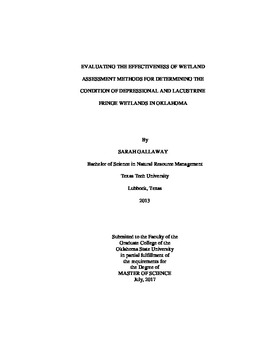| dc.contributor.advisor | Davis, Craig A. | |
| dc.contributor.author | Gallaway, Sarah Elizabeth | |
| dc.date.accessioned | 2018-06-13T16:19:35Z | |
| dc.date.available | 2018-06-13T16:19:35Z | |
| dc.date.issued | 2017-07-01 | |
| dc.identifier.uri | https://hdl.handle.net/11244/300027 | |
| dc.description.abstract | The U.S. Environmental Protection Agency has developed a three-tiered framework to categorize wetland assessments. Level 1 assessments are conducted remotely and condition is evaluated based on surrounding land-use. Level 2 assessments rely on rapid assessment methods (RAMs) to evaluate condition. Level 3 assessments use the most intensive sampling techniques to produce quantitative data. RAMs have become the preferred method for many programs, because they are conducted on-site, and require less time and expertise than Level 3 methods. Because RAMs are based on best professional judgment and inferred relationships between indicators of stress and wetland condition, validation with intensive data is necessary to confirm that condition scores are reflected in quantifiable components of the ecosystem. Chapter 1 presents our validation analysis of the Oklahoma Rapid Assessment Method (OKRAM) in 28 depressional wetlands across the state. We found strong, consistent relationships between OKRAM scores and Level 1 (e.g., Landscape Development Intensity Index) and Level 3 (e.g., plant and soil) data to suggest that OKRAM is tracking condition within the wetland as well as with anthropogenic disturbance factors in the surrounding landscape. Chapter 2 presents the initial application of OKRAM in 30 lacustrine fringe wetlands within central Oklahoma, alongside abiotic (e.g., soil and water quality) and biotic (e.g., vegetation and macroinvertebrate) data collection. Our analysis did not reveal consistent relationships between OKRAM and intensive data, indicating the method requires further modification. In addition to RAMs, Floristic Quality Assessment (FQA) is also used to evaluate wetland condition and guide conservation and management efforts. FQA results are assumed to be valid across large regions, despite areas of high environmental variability. Given the diverse ecoregions and environmental gradients across the state, Oklahoma provides an opportunity to examine spatial variation on FQA results. Chapter 3 presents our evaluation of 68 depressional wetlands to examine the influence of environmental variation on FQI scores. We found substantial variation between reference wetlands based on location, with higher scores occurring in the east (high precipitation) and lower scores occurring in the west (low precipitation). Our results highlight the importance of considering regional environmental differences when developing thresholds for wetland assessments. | |
| dc.format | application/pdf | |
| dc.language | en_US | |
| dc.rights | Copyright is held by the author who has granted the Oklahoma State University Library the non-exclusive right to share this material in its institutional repository. Contact Digital Library Services at lib-dls@okstate.edu or 405-744-9161 for the permission policy on the use, reproduction or distribution of this material. | |
| dc.title | Evaluating the Effectiveness of Wetland Assessment Methods for Determining the Condition of Depressional and Lacustrine Fringe Wetlands in Oklahoma | |
| dc.contributor.committeeMember | Fuhlendorf, Sam | |
| dc.contributor.committeeMember | Dzialowski, Andy | |
| osu.filename | Gallaway_okstate_0664M_15338.pdf | |
| osu.accesstype | Open Access | |
| dc.description.department | Natural Resources and Ecology Management | |
| dc.type.genre | Thesis | |
| dc.type.material | text | |
